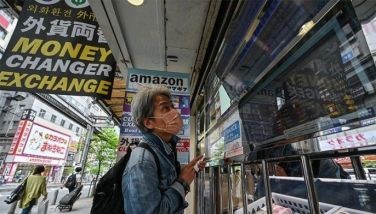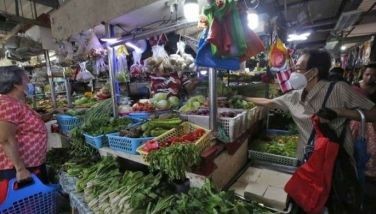Ignoring food security flashpoints

In the list of priorities that the President often refers to, agriculture and food security rarely fails to catch my attention. Even as global supply chains are returning to normal, a host of other developing conditions continue to act as potential flashpointsto a food crisis for the country.
Being a net importer of food items, the Philippines continues to be vulnerable to fluctuations in international
food prices and supply chain disruptions. Therefore, such factors as population growth, limited agricultural resources, and natural disasters become huge risks. Locally, while past efforts to modulate our population growth has resulted to a modest rate of 1.5 percent, the country’s large population base continues to pose challengesin securing food resources given the declining contribution of domestic agriculture for the nation.
Among the global issues that continue to percolate, climate change by far represents the biggest threat to our food security. When the simple supply shortage of imported onions sent our inflation data on a tailspin, it worries me
how even a whiff of a rice shortage can affect us. Even if we import only a small percentage of our rice needs, the absolute numbers represent a sizable amount for the dining tables of many households, usually those in the low-income levels, should the country fail to secure importations for whatever reason. When major rice producing and exporting countries like Thailand and India report potentially poor harvests because of droughts, flooding, or even the drying up of major water sources for agriculture, assurances of adequate stocks in bodegas are not guarantees of stable prices.
While current agrarian laws have somehow blunted the weight of rice on the country’s consumer price index, the reality remains that the Philippines is the world’s single largest rice importer, and is, therefore, vulnerable to any significant curtailment of rice exports.
Reviewing the RCEF
For this reason alone, the government needs to prioritize rice self-sufficiency. This means focusing on raising our own rice production, which does not only mean providing more subsidies to encourage farmers to go back to rice farming.
The Rice Competitiveness Enhancement Fund (RCEF), which receives P10 billion annually until 2026, should be closely monitored especially now that it has been around for half its life. The RCEF, according to the Rice Tariffication Law that created it, should have provided for financial assistance to rice farmers to improve their productivity.
But more than that, half of its yearly funds should have gone to the mechanization and modernization of rice farming. By now, we should have been seeing significantly increased rice production through the use of better farming implements.
Shouldn’t the President ask for a progress report on this, not just in his capacity as agriculture chief, but as the guardian of food security for a nation of over 110 mmillion Filipinos? Now is not too early. We might wake up one morning to news of widespread corruption in administering the RCEF, which by now should have received over P30 billion already.
Kadiwa’s vulnerability
The President, during his first State of the Nation Address (SONA) last year, delved much more on food security. Then, he talked of improving the production of agricultural commodities by enhancing the value chain system from production to retail.
In this year’s SONA, BBM boasted about how the Kadiwa stores, a resurrected project of his parents half a century ago, has been bringing down prices of agricultural products by cutting out middlemen and reducing price markups along the supply chain.
The Kadiwa stores, unfortunately, are dependent on government support to survive, such that any withdrawal of funds and logistics that have been oiling this initiative would make the whole program grind to halt almost instantaneously. It is highly improbable that the structure on how it operates will induce sustainability so that target farmers and fisherfolk will set up their own systems to bring their produce to the Kadiwa stores, thereby bypassing a well-entrenched and well-financed logistics system.
At the current near-poverty state of our farmers and fisherfolk, hiring a jeep to bring their produce to the nearest Kadiwa store may not be feasible. Without the necessary funds, they would rather cede such marketing functions to the all-too-willing middleman. On the other hand, if the government were to act as middleman, the amount needed to sustain this role would be go beyond the agriculture department’s budget. This is the very reason why the Kadiwa stores of yesteryears faltered.
Full-time agriculture chief needed
How much time has the President really allocated to agriculture during his first year? His inability to name someone more capable who can give full time and energy to oversee many of the country’s agriculture-related
projects and programs has become detrimental to his intention to establish the country’s food security.
Are the machineries and modern agricultural implements working to improve farm productivity? Or the more basic question is if the RCEF money really goes to our rice farms and farmers? We may wake up one morning to another scandal, perhaps much bigger than the P10-billion pork barrel fund anomaly in 2013 where the Department of Agriculture figured prominently. We’d like to see the President, or someone with truly a heart for Philippine agriculture and the country, working hard to see that the farmlands, fisheries, orchards, poultries, and livestock farms teem with produce and become profitable to those who tend them.
Six hundred thousand of our farmers may have been freed from a big part of their debts, but that does not ensure that they will be on the road to a better life. The real work has only started, and someone has to do it.
Facebook and Twitter
We are actively using two social networking websites to reach out more often and even interact with and engage our readers, friends, and colleagues in the various areas of interest that I tackle in my column. Please like us on www. facebook.com/ReyGamboa and follow us on www.twitter. com/ReyGamboa.
Should you wish to share any insights, write me at Link Edge, 25th Floor, 139 Corporate Center, Valero Street, Salcedo Village, 1227 Makati City. Or e-mail me at reydgamboa@yahoo. com. For a compilation of previous articles, visit www.BizlinksPhilippines. net.
- Latest
- Trending




























